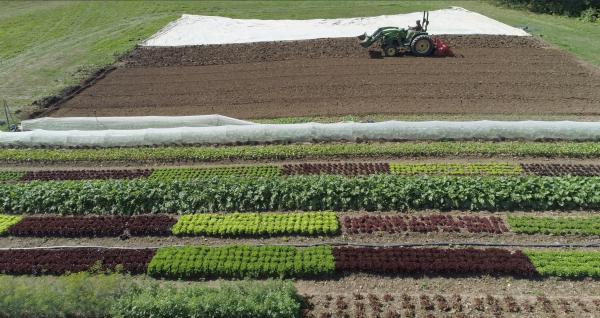I saw the market garden 2 weeks ago: everything looked wonderful. But how, in an organic garden do you keep insects from damaging the plants? My string bean leaves are full of holes.
This is the prime season for gleaning in the Market Garden and at farms around Vermont. That means harvesting extra produce from the fields. Maybe a farmer doesn’t have the time or staff to harvest everything, or there’s more produce than what’s needed for their markets. Either way, farmers don’t like to see food go to waste, so typically, volunteers or volunteer organizations come and harvest this still-good produce before it goes bad, at no cost.
Gleaning is a way for the Farm to support and give back to our community. More broadly, it has a valuable role to play in reducing food waste and food insecurity. According to the book Drawdown, a third of the food raised or prepared worldwide does not make it from farm or factory to fork, which ranks reducing food waste as the third most effective means to combat global warming.
Shelburne Farms has great gleaning relationships with the Intervale Food Hub, which offers free CSA shares, the Vermont Foodbank, and Shelburne Food Shelf. The Food Hub and Foodbank harvest from our fields every two weeks or so at the height of the season. We actually pick the produce for the Shelburne Food Shelf ourselves. Last year, we donated more than $2,000 worth of gleaned produce.
Gleaning is extremely simple in concept, but arranging the details takes some back and forth.
From my perspective, we have some crops--like kale--that are always there, and there’s always extra. Those crops can be gleaned almost any time. Crops like squash and beans, on the other hand, have windows of opportunity for picking before they get overripe and unappealing. And once these crops start to go, I’m eager to mow them down in order to keep weeds, disease, and pests at bay.
The gleaners’ perspective is a little different. They’re looking for a certain amount of produce to glean to make it worth their time and effort (typically, that’s roughly a pickup truck’s worth of produce.) They have to think about how many volunteers they have, and what crops people like to eat. The gleaning organizations themselves often like root crops like potatoes or onions because they hold up longer, but their customers often prefer more perishable crops that they often can’t afford, like tomatoes or cucumbers.
Working out the when, where, and what to pick just takes conversation. When the volunteers arrive, my job is mostly to point out the crops. “Pick two eggplants per plant,” I might say. Or, “We’re going to mow down these squash plants tomorrow. Take any of them.” They might counter, “Oh, we can’t take the squash today, but can you wait to mow it until we come back next week?” I’m usually fine with that. So this is where the conversation happens, and where the relationships get built.
It’s been great to foster these relationships with the Intervale Food Hub and food shelves over the past half dozen years. It’s so important. I love to grow food for people, and it’s the folks at these organizations who really connect me to the people eating the gleaned food that we grow here at Shelburne Farms. They’ll take photos of the recipients, or send me texts: “Everyone loves it!” They are so thoughtful and thankful. What farmer wouldn’t be happy about that?
Comments
We start with a plant positive approach: high fertility soils, strong transplants, and lots of water. Most gardens are not watered enough. We row cover or use insect netting to protect plants when they are small. We use organic sprays when bugs are a problem. We also rotate crops to different fields so pest and disease pressure does not build up in a certain field. This is a luxury most small gardeners do not have. Hope this helps.

